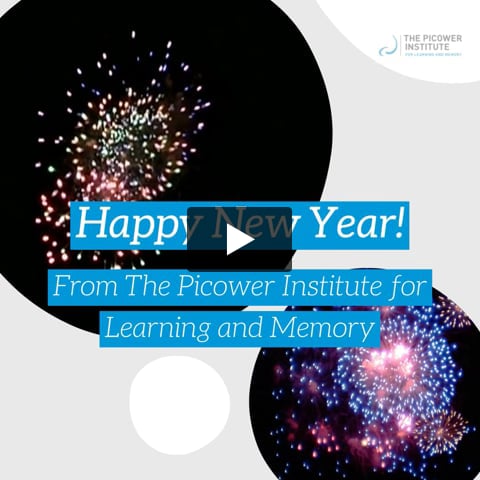Happy New Year from The Picower Institute!
No images? Click here
Picower Research & Discoveries
Anesthesia blocks sensation by cutting off communication within the cortex

Under propofol general anesthesia, sensory input still reaches the brain, but signals do not spread. Results suggest consciousness requires cortical regions to all be “on the same page.”
General anesthesia evokes a dual mystery: How does it disrupt consciousness, including sensory perception, and what might that say about the nature of consciousness. A new study led by researchers at The Picower Institute provides evidence in animals that consciousness depends on properly synchronized communication across the brain’s cortex and that the anesthetic drug propofol cancels sensory processing by cutting it off. Story continues>>
How a mutation in microglia elevates Alzheimer’s risk

A new MIT study finds that microglia cells with mutant TREM2 protein reduce brain circuit connections, promote inflammation and contribute to Alzheimer’s pathology in other ways
A rare but potent genetic mutation that alters a protein in the brain’s "microglia" immune cells can give people as much as a three-fold greater risk of developing Alzheimer’s disease. A new study by Picower Institute researchers details how the mutation undermines microglia function, explaining how that seems to generate the higher risk. Story continues>>
Nanoparticle-delivered RNA reduces neuroinflammation in lab tests

In mice and human cell cultures, MIT researchers showed that novel nanoparticles can deliver a potential therapy for inflammation in the brain, a prominent symptom in Alzheimer’s disease
Some Covid-19 vaccines safely and effectively used lipid nanoparticles (LNPs) to deliver messenger RNA to cells. A new MIT study shows that different nanoparticles could be used for a potential Alzheimer’s disease therapy. In tests in multiple mouse models and with cultured human cells, a newly tailored LNP formulation effectively delivered small interfering RNA to the brain’s microglia immune cells to suppress expression of a protein linked to excessive inflammation in Alzheimer’s disease. Story continues>>
Evidence early, but emerging, that gamma rhythm stimulation can treat neurological disorders

A broadening landscape of studies show what’s known, and what remains to be found, about the therapeutic potential of non-invasive sensory, electrical or magnetic stimulation of gamma brain rhythms.
A surprising MIT study published in Nature at the end of 2016 helped to spur interest in the possibility that light flickering at the frequency of a particular gamma-band brain rhythm could produce meaningful therapeutic effects for people with Alzheimer’s disease. In a new review in the Journal of Internal Medicine, the lab that led those studies takes stock of what a growing number of scientists worldwide have been finding out since then in dozens of clinical and lab benchtop studies. Story continues>>
Picower People
New Picower Investigator advances optical methods to study learning and memory
Like the beams of light she precisely patterns to probe and control the brain’s electrical activity, Linlin Fan’s research interests have developed a clear focus: advancing technology to make discoveries about how memory works. So where better to launch her career as a primary investigator than The Picower Institute for Learning and Memory and the Department of Brain and Cognitive Sciences at MIT. Story continues>>
Emery N. Brown elected member of American Philosophical Society

After his election to the American Philosophical Society earlier this year, Emery N. Brown signed the Roll Book of the nation’s oldest learned society for the first time as a member. Story continues>>
In the media

Science News featured Emery Brown and Earl Miller's paper describing a new system to make anesthesiology more precise. Neuroscience News produced a video interpreting their study about how anesthesia cuts off communication in the cortex. The Atlantic reported on a study that built on the Miller Lab's past research into how we assess numbers. Scientific American quoted Matt Wilson in a story about whether rats imagine the future. A recent honor for Elly Nedivi gained notice in WIA Report.
Forbes contributor William Haseltine recently wrote a series on research by Li-Huei Tsai, Emery Brown and Ed Boyden on sensory stimulation of gamma rhythms to treat Alzheimer's (see part 1, part2, and part 3). Tsai also gave an interview to YouTube vlogger Mark Mattson on the topic. Her research on how a gene mutation contributes to Alzheimer's risk earned a story in GEN, and Drug Target Review was among the outlets that covered her lab's nanoparticle research collaboration with the lab of Bob Langer.
Speaking of series, MIT's Industrial Liaison Program produced a great set of stories and videos profiling three Picower Institute professors. Check 'em out to learn the latest from three of our labs:
Tune into Mi Última Neurona
Earlier this year, Jessica Chomik-Morales, a post-bacc researcher in MIT's Brain and Cognitive Sciences Department, embarked on a five-week journey across seven countries in Latin America. Her mission: to delve into and showcase the remarkable research of Hispanic and Latinx scientists in the region. This endeavor constitutes the third season of her podcast "Mi Última Neurona," produced in Spanish and co-sponsored by The Picower Institute. This season premiered September 18th on YouTube, following two successful seasons available on Spotify, Apple Podcasts, and miultimaneurona.com.

Upcoming Events
A note about events: Event schedules and details are subject to change. Please check associated links frequently in advance of events that interest you.

Save the date for The 2024 Picower Lecture with Hongkui Zeng, PhD, director of the Allen Institute for Brain Research in Seattle, WA.
Tuesday, April 23 at 4:00pm, Singleton Auditorium (46-3002). More>>
Upcoming colloquia and Aging Brain Initiative seminars
- February 27: Aging Brain Seminar with Randy Buckner, PhD, Harvard University, MGH More>>
- March 14: Colloquium on the Brain and Cognition with Jason Shepherd, PhD, University of Utah More>>
- April 18: Colloquium on the Brain and Cognition with Daniel Colón-Ramos, PhD, Yale University More>>
- April 25: Colloquium on the Brain and Cognition with Thomas Clandinin, PhD, Stanford University More>>


